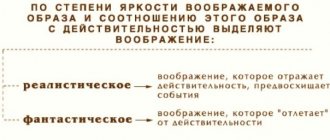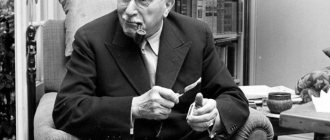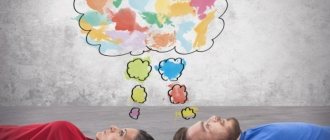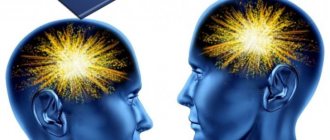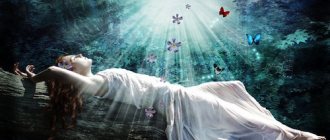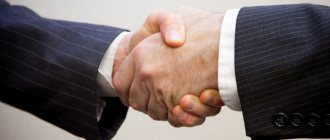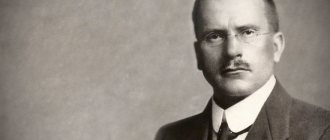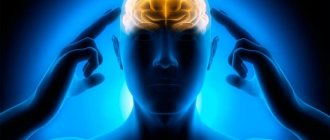Complexes, archetypes and the collective unconscious
Carl Gustav Jung is known as a follower of Freud who continued the development of psychoanalytic theory. True, he did not follow Freudian traditions, but went his own way. Therefore, their cooperation was not so long. The concept of the collective unconscious was the main reason for the differences in views between them.
Article on the topic 5 most famous psychological experiments of all time According to Jung, the structure of the personality (he called it the soul) consists of the Ego, the Personal Unconscious and the Collective Unconscious. The ego is what we used to call consciousness, or everything we mean when we say “I”. The personal unconscious is personal experience, for some reason forgotten or repressed, as well as everything that we don’t seem to notice around us. The personal unconscious consists of complexes - these are emotionally charged groups of thoughts, feelings and memories. Each of us has mother and father complexes - emotional impressions, thoughts and feelings associated with these figures and the scenarios of their life and interaction with us. A common power complex in our time is when a person devotes a lot of his mental energy to thoughts and feelings about control, dominance, duty, and submission. The inferiority complex, etc., is also well known.
The collective unconscious contains thoughts and feelings that are common to all people, the result of our common emotional past. As Jung himself said: “The collective unconscious contains the entire spiritual heritage of human evolution, reborn in the structure of the brain of each individual.” Thus, the collective unconscious is passed down from generation to generation and is common to all people. Examples include mythology, folk epic, as well as the understanding of good and evil, light and shadow, etc.
By analogy, just as complexes make up the content of the personal unconscious, the collective unconscious consists of archetypes - primary images that all people imagine in the same way. For example, we all react in approximately the same way to parents or strangers, death or a snake (danger). Jung described many archetypes, among which are the mother, the child, the hero, the sage, the rogue, God, death, etc. Much of his work is devoted to the fact that archetypal images and ideas are often found in culture in the form of symbols used in painting, literature and religion. Jung emphasized that symbols characteristic of different cultures often show striking similarities precisely because they go back to archetypes common to all humanity.
How is this applied today?
Today, this knowledge is widely used in the work of psychologists and psychotherapists of all directions. It’s quite difficult to underestimate the word “complex” or “archetype” in the work of a psychologist, would you agree? At the same time, the analyst does not label you, but knowledge about the nature and scenario of archetypes and your complexes helps to better understand your personal “psychic kaleidoscope.”
It both heals and cripples. How psychiatry developed
More details
Practical application of the concept of psychotypes by C. Jung today
Today, it will not be difficult for a psychologist to determine the basic personality type. The main use of this work by Jung is career guidance. After all, if a person is withdrawn and does everything slowly, for example, as a salesperson in a high-traffic sales area, as in general, it is better not to work as a salesperson. Since this profession involves a large number of contacts during the day, and not always comfortable ones, which can greatly undermine the psychological health of an introvert. And the effectiveness of such activities will be low. If, on the contrary, a person belongs to the basic extroverted type, he can safely choose activities associated with a large number of personal contacts, including as a leader - manager or director.
This theory is also used in family psychology. Moreover, at the stage of family planning. Since, if a couple, say, consists of a typical extrovert or a typical introvert, the life of such a marriage will be short-lived. After all, if the wife has a desire to focus on her husband, limiting his non-work communication, being the most introverted person, and the husband, on the contrary, being a typical extrovert, has a need for a large number of guests in their home or a desire to often be in the company of friends, this can serve the cause of discord, and possibly divorce. But, since psychotypes with the most prevalent one typical attitude are quite rare, it is possible to choose a partner who, even being an extrovert, will be able to pay enough attention to his life partner and have a not particularly pronounced need for frequent friendly contacts.
Literature:
- Jung K. G. Psychological types. M., 1998.
- Babosov E.M. Carl Gustav Jung. Minsk, 2009.
- Leibin V. Analytical psychology and psychotherapy. St. Petersburg, 2001.
- Khnykina A. Why is Jung so brilliant? 5 main discoveries of a psychiatrist // Arguments and facts - 07/26/15.
Author: Elena Andreeva psychologist
- To write or not to write? - that is the question https://psychosearch.ru/7reasonstowrite
- How to become a partner of PsychoPoisk magazine? https://psychosearch.ru/onas
- Several ways to support PsychoSearch https://psychosearch.ru/donate
| If you notice an error or typo in the text, highlight it with the cursor and press Ctrl + Enter | Didn't like the article? Write to us why, and we will try to make our materials better! |
Analytical psychology
After receiving a medical degree in psychiatry from the University of Basel, young Jung became an assistant in a clinic for the mentally ill under the direction of Eugene Bleuler, the author of the term “schizophrenia.” Interest in this mental illness led him to the works of Freud. Soon they met in person. Jung's education and depth of views made a tremendous impression on Freud. The latter considered him his successor, and in 1910 Jung was elected the first president of the International Psychoanalytic Association. However, already in 1913 they broke off relations due to differences in views on the unconscious, as I said above - Jung identified the collective unconscious, with which Freud did not agree, and also expanded and supplemented the concept of “complex” to the form in which it has survived to this day. And then Jung went on his own inner path. His autobiography, Memories, Dreams, Reflections, begins with the statement: “My life is the story of the self-realization of the unconscious.”
Article on the topic
I made a Freudian slip. What our mistakes, slips and forgetfulness will tell us As a result of this “self-realization of the unconscious”, Jung had a whole complex of ideas from such different fields of knowledge as philosophy, astrology, archeology, mythology, theology and literature and, of course, psychology, superimposed on his psychiatric education and Freud's ideas about the unconscious. The result was what is today called analytical psychology.
Plus, Jungians (as psychologists who adhere to Dr. Jung’s theory call themselves - analytical psychologists) actively use a range of other psychological methods: art therapy, psychodrama, active imagination, all types of projective techniques (such as analysis of drawings), etc. Jung was especially fond of art therapy - creativity therapy. He believed that through continuous creative activity one could literally prolong one's life. With the help of creativity (art therapy), any spontaneous types of drawing, especially mandalas (a schematic image or design used in Buddhist and Hindu religious practices), deep layers of the psyche are released.
How is this applied today?
Psychoanalysts around the world are divided into Freudians and Jungians. An orthodox Freudian psychoanalyst will place you on the couch, sit at the head of the bed and listen to you with a minimal presence, 2-3 times a week for 50 minutes. All visits, including missed ones, are paid. Time does not change or move, even if you work every other day and are unable to comply with agreements on your work schedule. But when you express a desire to find out why the analyst is so unfair to you and does not want to get into your position, you will be asked a couple of questions about why everything in your life is so inconvenient? And also who is usually inclined in real life to enter into your circumstances and adapt to you?
The Jungians approach things differently. As a rule, this is once a week, and the conditions can be negotiated and be more flexible. For example, sessions missed for valid reasons can be worked out at another time. It is not at all necessary to lie down on the couch; you can sit on armchairs and talk, as you are used to in everyday life. Also, in addition to the dialogue, you may be asked to comment on the image, fantasize out loud, and then draw your fantasy or feeling, imagine someone opposite you and talk to him, moving first to his place, then back to yours, they may be asked to make something something made of clay or sand...
The boundaries and rules of communication between the analyst and the patient still remain quite strict, which determines the quality of the contact and, accordingly, the work.
Today we can safely say that all areas of psychotherapy and practical psychology are rooted in analytical and projective practice. Thus, analytical psychology is something that combines basic knowledge of psychoanalytic practice, the collective centuries-old experience of people working with their inner world and its self-expression and modern achievements in the science of the soul - psychology.
Psychiatrist: “People are afraid of getting cancer, but almost no one is afraid of going crazy”
More details
Education
At the age of 11, Jung was sent to the Basel gymnasium. Through the efforts of his father, at that time he already knew Latin quite well and, it would seem, being already ahead of his peers, he should have studied successfully. However, he showed no interest in science, and only read ancient books or enthusiastically drew ancient castles. As he himself said, this was caused by a feeling of dual personality that did not leave him - he claimed that since childhood he had “ two selves
.”
By the age of 16, both loneliness and bouts of depression gradually began to subside. Fascinated by philosophy, Jung immersed himself in reading Pythagoras, Heraclitus, Plato, and he even found reflections of his thoughts in the works of such a German philosopher as Arthur Schopenhauer.
At the age of 18 he entered the University of Basel, the Faculty of Natural Sciences. Due to the death of his father, there was no one in his family to bring money, so in his free time from studying, he worked as a tutor, which paid for his studies and a rather modest existence.
At the same time, he became interested in the works of such mystical philosophers as Emmanuel Swedenborg and Adolf Eschenmayer, and there were even several spiritualistic seances. Oddly enough, this helped him write a dissertation on medicine, which was called: “On the psychology and pathology of so-called occult phenomena.”
He returned to this again, still for research purposes, in order to correctly formulate commentaries on such texts as the I Ching, The Secret of the Golden Flower and The Tibetan Book of the Dead.
The “Textbook of Psychiatry,” authored by Richard von Krafft-Ebing, which came before the final exams, determined the further receipt of a medical degree in psychiatry. Jung " suddenly understood the connection between psychology, or philosophy, and medical science
».
It is worth mentioning that the phrase “ Whether called or not, God is always present”
“he not only included it in his bookplate, but much later ordered it to be carved on the stone arch that was located above the front door. The Christian Church will condemn his works more than once, but he himself will remain a deeply religious person.
At the age of 21, he first met his future wife, Emma Rauschenbach, from an old German-Swiss family. Gustav immediately liked the sweet, modest girl with thick hair neatly braided into a braid.
Concept of psychological types
Article on the topic
Color treatment: what colors will relieve stress, boredom and fatigue Jung introduced the concepts of extraversion and introversion as the main types of personality orientation (ego orientation). According to his theory, which has been richly supported by practice around the world for about 100 years, both orientations exist in a person simultaneously, but one of them usually leads. Everyone knows that an extrovert is more open and sociable, while an introvert is all about himself. This is the popular version of these concepts. In fact, everything is not quite like that; extroverts can also be closed. An extrovert's psychic energy is directed outward - towards the situation and the people around him, his partners. He influences all this himself, as if bringing the situation and surroundings into the “right form”. An introvert acts in exactly the opposite way, as if the situation and surroundings are influencing him, and he is forced to retreat, make excuses or defend himself all the time. In his book Psychological Types, Jung provides a possible biological explanation. He says that there are two ways of adaptation to the environment in animals: unlimited reproduction with a suppressed defense mechanism (as in fleas, rabbits, lice) and a few offspring with excellent defense mechanisms (as in elephants, hedgehogs and most large mammals). Thus, in nature there are two possibilities for interacting with the environment: you can protect yourself from it, building your life as independently as possible (introversion), or you can rush into the outside world, overcoming difficulties and conquering it (extroversion).
Later, Jung supplements his theory of psychotypes with four main mental functions. These are thinking and feeling (rational), sensation and intuition (irrational). Each of us has each of these functions, in addition, each function can be oriented outward or inward and can be extroverted or introverted. In total, we get 8 different mental functions. One of them is the most convenient for adaptation, therefore it is considered the leading one and determines the personality type of the same name according to Jung: thinking, feeling, sensing or intuitive (extroverted or introverted).
How is this applied today?
The leading personality type for a practicing psychologist is not difficult to determine, and this gives a lot of information about a person, in particular about his way of perceiving and delivering information and adapting to reality.
For example, if a person’s leading function is thinking, it will be difficult for him to talk about his feelings and sensations, he will reduce everything to facts and logic. A person with leading extroverted thinking lives under the yoke of a sense of justice. Most often these are military personnel, directors, teachers (mathematics, physics). All of them, as a rule, are tyrants, since they have strong cause-and-effect relationships, it is difficult for them to imagine that for some reason they can be violated, they always focus on objective facts of the world around them that have practical significance.
But for example, a person with leading introverted intuition will be focused on the inner world and his own ideas about external reality, he calmly treats the people and objects around him, preferring to live his life inside rather than making an impression on the outside.
Based on Jung’s typology, a lot of simplified similarities have been created, the most famous of which is socionics.
Inside or outside. Who are you: an introvert or an extrovert?
More details
Activity
Having moved to Zurich, in 1900 he entered a clinic for the mentally ill, as an assistant to the author of the term “schizophrenia” - Eugene Eugene Bleuler. Having settled in Blade territory, he soon began to publish his first clinical works, as well as articles that revealed the use of the word association test, which he himself had developed. The collected clinical material supplemented the observations made during spiritualistic seances, which made it possible to publish a book of the same name as his dissertation.
«The split personality of the spiritualist medium goes back to certain inclinations in infancy, and the presence of manic sexual desires can be traced to the basis of hallucinatory systems
“,” noted Jung.
Repeatedly referring to such works of Freud and Bleuler as “The Interpretation of Dreams” and “Studies on Hysteria,” he already then clearly defined the direction of his future work, in particular, its deviation from Freud’s position.
On February 14, 1903, Carl Jung married Emma Rauschenbach. She always showed a sincere interest in her husband's work and supported him in everything, and given her financial status, Jung could devote his time entirely to research. In 1904, his wife gave birth to his daughter Agatha.
On August 17, 1904, 18-year-old Sabina Spielrein was admitted to the clinic. The relationship between doctor and patient quickly developed into that of lovers, and their relationship became public knowledge. Jung appreciated the girl’s sharp mind and scientific way of thinking, and Spielrein could not help but fall in love with the doctor, who had a keen sense of the world. However, immediately after the illness was cured, Sabina left the clinic, and the relationship ended.
In 1906, his wife gave birth to his second daughter, Greta. In the same year, he published the book “The Psychology of Dementia Early,” which began with one of the best reviews of the theoretical literature of that time on this topic. He based his position on a synthesis of the ideas of various scientists, including Kraepelin, Janet, Bleuler and Freud. Adherents of the latter spoke about the book like this:
«...made a revolution in psychiatry
" - Jones.
«...became the cornerstone of modern interpretative psychiatry
" - Brill.
Jung also earned a reputation as the pioneer of the psychosomatic model of this disease. According to his theory, the characteristic symptoms of dementia praecox are the result of a brain-damaging toxin that is produced as a result of affect. He later abandoned this hypothesis in favor of the more modern concept of a disorder of chemical metabolism.
«...it is impossible to do without psychology when explaining the causes and nature of primary emotions that cause changes in metabolism. These emotions appear to be accompanied by chemical processes that cause specific short-term or chronic changes or damage to organs
", he wrote in 1958.
With his book, Jung drew widespread attention to the theories of Freud, "an almost unrecognized researcher
", and before finishing his book, in April 1906, he began correspondence with Sigmund himself, to whom he sent a copy of his book.
At the end of February 1907, Jung went to Vienna to meet Freud, along with his wife and freelance doctor Ludwig Binswanger. The first conversation, which he later called “ a review of horizons”
", lasted 18 hours without a break.
According to Jung, Freud " is impressive and at the same time he is 'strange' for a man of his qualifications
."
In a letter intended for Abraham, Sigmund wrote about Jung: “ Only his appearance on our stage saved psychoanalysis from becoming a national Jewish enterprise
.”
He saw in him " Jesus, destined to explore the promised land of psychiatry
", and he himself, "
like Moses, could only look at it from afar
."
A few months later, Jung founded the Freudian Society in Zurich. And the report in defense of psychoanalysis, “The Freudian Theory of Hysteria,” which he read at the first International Congress of Psychiatry and Neurology in Amsterdam, essentially turned into an apology for Freud’s ideas.
In 1908, his wife gave birth to his son Franz, and Jung organized the first International Congress on Psychoanalysis in Salzburg and founded the Yearbook of Psychoanalytic and Pathopsychological Research, which he became editor, and Freud and Bleuler co-directors.
In 1909, Jung and Freud arrived in the United States, where he gave a course of lectures. In the same year, 21-year-old Toni Wolf came to Jung as a patient, and after her recovery she became his official mistress and also his assistant. In September 1911, she even accompanied the Jung family to the Weimar Congress of the International Psychoanalytic Society. Toni accompanied him in life and work for 40 years; together they published the book “Metamorphoses and Symbols of Libido.” The wife was well aware of this affair, but her boundless love for her husband did not allow her to file for divorce.
In 1910, he resigned as director of the Burgelzli Clinic, after which Jung returned to his native land and plunged into in-depth research into myths, legends, and fairy tales in the context of their interaction with the world of psychopathology. During the Nuremberg Congress, the International Psychoanalytic Association was founded, of which he was elected president. He became the first and youngest president of the association in its history, even despite the angry protest of the Vienna group. That same year, his wife gave birth to his daughter Marianna.
The articles published during the years of defending Freud's theories no longer sparkled with the same originality, and Jung himself began to feel growing anxiety. In 1907-1910 he was visited by such Moscow psychiatrists as Mikhail Asatiani, Nikolai Osipov and Alexey Pevnitsky, all at different times. In 1911, the book “Metamorphoses and Symbols of the Libido, Part I” was published, in which he tried to apply the principles of psychoanalysis to myths, legends, fables, classical plots and poetic images, and in 1912 the second volume of the book was published. In his books, Jung deprives “libido” of sexual connotations, contrary to Freud’s ideas. In The Psychology of the Unconscious, published the same year, he refuted many of Freud's ideas.
He identified the collective unconscious, contrary to Freud’s opinion, expanded and supplemented the concept of “complex”. Jung's ideas related to philosophy, astrology, archaeology, mythology, theology, literature and psychology, and their result was analytical psychology. He also believed that everyone has “ a complete personality sketch... presented in potency from birth
“, and “
the environment does not at all give the individual the opportunity to become one, but only reveals what was already inherent in it
,” which contradicted a number of provisions of psychoanalysis.
Freud's ideas for the most part influenced him in the period before his personal meeting, but he himself did not retreat from mysticism, where the idea of the collective unconscious arose from his first work. The relationship between them soon became purely business, and in September 1913 they decided to end all communication, meeting for the last time at the International Congress in Munich, where Jung was re-elected to the International Psychoanalytic Association.
The drama of the separation turned into an opportunity for Jung to publish such works as “Symbols of Transformation” and “The Red Book.” A month later, he resigned as editor of the Yearbook of Psychoanalytic and Pathopsychological Research, and in April 1914 he left the International Psychoanalytic Association and no longer used the technique of psychoanalysis in his practice.
In July 1914, “The History of the Psychoanalytic Movement” was published, in which Freud showed the complete incompatibility of his ideas with the views of Jung and Alfred Adler. After this, the entire Zurich group left the International Association. That same year, Jung's wife gave birth to his last daughter, Helena.
In analytical psychology, Jung, in contrast to Freud, who concentrated on the dissatisfaction of sexual desires, digs deeper and wider, consistently developing and refining all the ideas created before him, including the best of Freud’s works.
In the 1920s he made a series of long trips to areas of Africa and North America. In 1921 he published the work “Psychological Types,” in which people were divided into introverts and extroverts, and the theory of archetypes was substantiated for the first time.
In 1922, after the death of his mother, he purchased a lakeside estate in Bollingham, not far from his home in Kusnacht, where he built the “Tower” for many years. Initially it was only a primitive round stone dwelling, but later it took on the appearance of a small castle, with two towers, an office, a fenced yard and a boat dock. In his autobiography, he described the construction process as “ an exploration of the structure of the psyche embodied in stone.”
" Throughout his life, he often stayed for long periods in the Tower, researching, painting and sculpting.
In 1930, Jung received the title of honorary president of the Psychotherapeutic Society of Germany and published the book “Problems of the Soul of Our Time.” In 1932 the council of Zurich awarded him a prize for literature with a check for 8,000,000 francs. In 1933 he became one of the inspirers and active participants in the International Intellectual Community "Eranos". In the same year he became a professor of psychology at the Federal Polytechnic University in Zurich.
From 1933 to 1939 he was the publisher of the Journal of Psychotherapy and Related Fields, which supported a national policy of racial purification, and the prologue to each publication invariably contained an excerpt from Mein Kampf. Later, in 1948, he mentioned in an interview with Karol Bauman that “ among his colleagues, acquaintances and patients in the period from 1933 to 1945 there were many Jews
" Jung himself claimed that this was a forced measure and was not officially convicted.
In order to study the traces of ancient civilizations, he visited the Indian Pueblo settlements located in the states of Arizona and New Mexico; at the extinct volcano Elgon, located in British East Africa; as well as in Egypt, India and Sudan. And after that I read reports at various international congresses.
He returned to teaching, giving weekly lectures at the ETH Zurich, and in 1937 he lectured on the relationship between psychology and religion at Yale University. In 1944 he became a professor at the department of medical psychology, which was specially dedicated to him at the University of Basel. He didn’t work there for long - in February he broke his leg during an excursion, and already suffered a heart attack in the hospital. The visions that visited him in those few weeks that he teetered on the brink between life and death were described in detail in his autobiography.
In April 1948, the Jung Institute was organized in Zurich, where training was conducted in English and German. Also, supporters of his method created the Society of Analytical Psychology in England, and similar ones in the USA and a number of other European countries.
In 1950, in honor of his 75th birthday, he installed a stone cube to the west of the Tower, on three sides of which he carved inscriptions. On the first - “ Here lies a stone, it is inconspicuous, its price is ridiculously low. But the wise appreciate what fools despise
" from "Rosarium philosophorum" and "
In memory of his 75th birthday, C. G. Jung gratefully made and installed, in the year 1950.
" On the second is Telesphorus, holding a lantern in his hand, around which an inscription in Greek is carved. On the third there is an inscription in Latin.
In 1955, in honor of his 80th birthday, he was elected an honorary citizen of Kusnacht, which he himself valued above election as a member of the Royal Society of Medicine in London. In November of the same year, Emma passed away, which completely devastated Jung. He immersed himself in his work, and his autobiography, recorded with the help of a secretary, took up a lot of his time. Over time, he had to hide bundles of letters behind bookshelves, because there was no time left for them.
In 1958, a congress on analytical psychology was held in Zurich - it was the first international congress, in which 120 delegates took part.
In May 1961, Jung had a new heart attack while walking, which caused blockage of blood vessels in the brain and partial paralysis of the limbs. After several weeks, during which he was again on the verge between life and death, the day before his death, he had a dream, after which he declared with a smile that he was no longer afraid of anything.
He died on June 6, 1961 at his home in Küsnacht. He was buried in the Protestant church cemetery, and the tombstone bore not only his initials, but also those of his parents, sister Gertrude and wife Emma.
Associative method
It all started with Freud's method of free association. According to Freud, you must give an association to an association that has just arisen. For example, you are bothered by a black raven outside the window (A), you should tell the psychoanalyst what pops up in your memory in connection with this image (B). Then the analyst will ask you to find an association (C) for the association that has arisen (B) and so on down the chain. As a result, you are supposed to tap into your Oedipus complex.
Jung once drew attention to the fact that people think about some words in an associative series longer than others. He thought that strong emotions cause confusion or confusion in the head, and for this reason it is more difficult to give a strong reaction. Thus was born Jung's association experiment, which is beautifully depicted in the film A Dangerous Method. In this experiment, Jung proves that the key value is the time spent building the association. Later, thought-provoking words are analyzed (usually for more than 4 seconds) and the meanings of the associations are interpreted.
How is this applied today?
Subsequently, on the basis of his associative experiment and Freudian free association, Jung created a method of amplification, when around one image (a raven in our example) many associations, images from cultural heritage, mythology, art are collected, leading the patient to an awareness of the complex behind it.
Genius and innovator. Why is Freud called a great scientist?
More details
Book number 6. Conflicts of a child's soul
Some of our readers may be surprised to see the term "soul" in a book about psychology. It is important to remember that in the work of Carl Jung this idea, this concept is always present.
As Jung explained in his autobiography, no doctor could cure a patient without making contact with the patient's soul.
This idea gives us the key to Jung's holistic approach to people. He believed that childhood and adolescence are the most important stages of a person's life, so we should pay much more attention to them. Thus, the possible conflicts, shortcomings and prejudices that the child experiences in his family, as well as the personality of the parents, undoubtedly determine the well-being or potential psychological problems of the child in later life.
It is curious that Sigmund Freud's daughter dedicated her life to this goal. She provided psychological assistance to children with childhood trauma . Freud himself never paid much attention to this area and did not fully develop it in his work.
Dream theory
From the point of view of Jung's theory, the influence of dreams constantly compensates and complements the person's vision of reality in consciousness. Therefore, awareness and interpretation of dreams in the analytical process with a psychologist allows us to pay explicit attention to the unconscious in the psyche. For example, a person may become angry with his friend, but his anger quickly passes. In the dream, he may feel intense anger towards this friend. A dream preserved in memory returns a person’s consciousness to an already experienced situation in order to draw his attention to a strong feeling of anger that was suppressed for some reason.
Article on the topic
In the kingdom of Morpheus. Interesting facts about sleep and dreams One way or another, a dream is considered as a breakthrough of unconscious content into consciousness.
When a patient tells a psychoanalyst his dream, the latter can use not only the patient's associative series, but also knowledge about archetypes, hierarchy and structure of symbols. Fairy-tale and mythological scenarios also allow us to interpret dreams.
How is this applied today?
Psychoanalysts and analytical psychologists interpret dreams and this is part of their work in the same way as the initial interview, active imagination or association test. You may be asked at your first psychoanalysis session about your most important dreams or what you may have dreamed in the run-up to your first visit. For the analyst, this will be very important information, not only diagnostic, but also prognostic in nature - often the first dream in the analysis describes future work.
The best books by Carl Jung
Jung's work is extensive and draws much material from his own autobiography, including books, essays and personal reflections. We can even find correspondence between Jung and Freud from 1906-1913. These letters delve into the development of the psychoanalytic movement and the relationship between these two figures.
Now, in this article about the best books of Carl Jung, our priority is to quote his most representative work. We are looking for books that will delight everyone, from beginners to seasoned Jungians, with their concepts, theories and ideas.
Basic provisions
Jung introduced new concepts into terminology that define the profound influence on the formation and formation of a person’s personality.
In a psychiatric clinic, under his supervision there were several dozen people with various mental disorders. Working with patients, Jung came to the conclusion that the integrity of the human psyche is not determined only by his consciousness.
There are systems that form the structure of personality under the influence of external and internal factors. These systems formed the basis of his teaching.
Carl Jung (1875-1961)
Book number 10. Memories, dreams, reflections
In these pages we learn about his formative years, his tense but productive relationship with Freud, and how each trip, conversation, discovery and experience shaped what he calls “the bottom of his soul.”
It is worth noting that the reader will not see a simple book of memories and personal reflections about someone in the twilight of his life. Jung takes full advantage of the opportunity to re-establish the foundations of his theories. He describes his ideas about the human mind, the unconscious, the role of symbolism and the principles of psychotherapy.
This book will help you better understand the thoughts of Carl Jung and his personal work as a psychologist.
